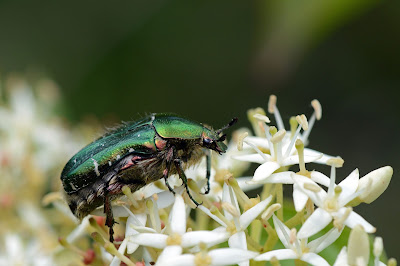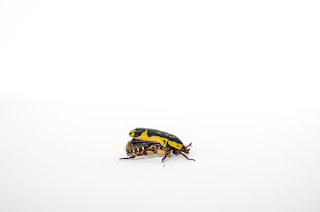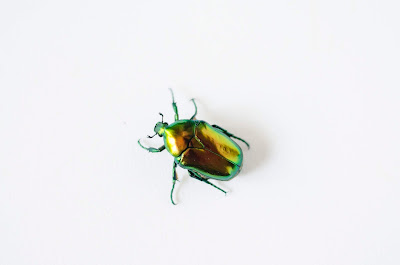Cetonia aurata: a common and variable palearctic species
In this post the species Cetonia aurata will be discussed. We will handle the following subjects:
1) General information
2) Cetonia aurata subspecies and forms
3) Economic value within beetle breeding
You can navigate through the text using ctrl+f and entering the desired title, or you can just read along.
1) General information
Cetonia aurata is a metalic flower chafer which measures between 12 and 20 mm. It has an enormous range across Eurasia. Populations occur locally in Scandinavia and the UK, but are abundant in most of the European mainland. Even in Belgium, a country with very small and fragemented habitats, the beetle has a fairly good distribution (for information in dutch click here).
Like many flower chafers they are most active in a sunny period right after rainfall (=high humidity and hot temperatures). The adults are then often feeding on flowers of elderflower, hawthorn and various umbellifers. However the beetle is also found on a variety of other flowering plants.
The beetles emerge in early spring, when their favourite weather and flowers are abundant. In temperate countries a smaller second generation turns up in late summer.
2) Cetonia aurata subspecies and forms
3) Economic value within beetle breeding
You can navigate through the text using ctrl+f and entering the desired title, or you can just read along.
1) General information
Cetonia aurata is a metalic flower chafer which measures between 12 and 20 mm. It has an enormous range across Eurasia. Populations occur locally in Scandinavia and the UK, but are abundant in most of the European mainland. Even in Belgium, a country with very small and fragemented habitats, the beetle has a fairly good distribution (for information in dutch click here).
Like many flower chafers they are most active in a sunny period right after rainfall (=high humidity and hot temperatures). The adults are then often feeding on flowers of elderflower, hawthorn and various umbellifers. However the beetle is also found on a variety of other flowering plants.
The beetles emerge in early spring, when their favourite weather and flowers are abundant. In temperate countries a smaller second generation turns up in late summer.
Because of their metalic green shine and loud sound in flight, they can not be overlooked when they are flying around. Another reason for spring hikes!
Although the beetle is very common, I truly love having them in my breeding. They are very active, long living, reproduce well and specimens tend to vary in color. Because they are so common in the wild, the species is not bred on a large scale in Europe. However the species makes for a perfect beginner beetle. Larvae and pupae are hardy and can survive a wide aray of conditions (too hot, too cold, too wet, too dry,...). The larvae are used to have diapauses, so there is no need to keep them in a hot environment during winter. No heating needed. Also without diapause they can develop and reproduce. Breeding and rearing boxes can even be kept outside.
2) Cetonia aurata subspecies and forms
Only recently I have discovered the great variability of this beetle. The descriptions and nomenclature on different subspecies and forms is rather complicated. Two of these subspecies enjoy my special interest for their great coloration and distributian close to Belgium. They are promising targets for selective breeding. There are more subspecies than those described. Because I have never handled specimens of these subspecies I didn't feel confident in describing them.
The most important source being this blog. Ofcourse, permission to use photo material was asked for and granted.
2.1) Cetonia aurata ssp aurata
The nominal subspecies, with the broadest range. Has a more cubic look to it, with punctuations across the entire pronotum and elytrae. The elytrae show rib-like elevations and most often strong white markings 2/3 down the elytrae. The species has less of a bright metallic shine to it in comparison with other subspecies. Various forms can be found in it's range. Generally the more northern populations tend to more green-golden-bronze. More southern populations show more of the green-purple-blue forms. A beautiful purple population can be found in the Ardèche region in France.
This is the subspecies I currently have in my breeding. I am selecting on coloration, but am always looking for alive blue, purple or deep bronze variations. Contact me if you might be able to catch some or have them in breeding.
Below some pictures of the nominal subspecies:
2.2) Cetonia aurata ssp. pisana
This subspecies has a fairly limited distribution, occuring in Italy, France and Corse. The punctuation of the elytrae and pronotum, that can easily be seen in the nominal species, is hard to see present in ssp pisana. Also the rib-like elevations on the elytrea are more subtle, almost invisible towards the distal parts of the elytrae. The pronotum of the subspecies is often more elongated compared to the nominal subspecies.
The blue form can be found mainly on the island of Corse. Someone should go collect them for breeding :)! Should you be able to get some, please let me know.
 |
| Cetonia aurata feeding on elderflower, by Cyril Lefevre |
 |
| Cetonia aurata by Cyril Lefevre |
Although the beetle is very common, I truly love having them in my breeding. They are very active, long living, reproduce well and specimens tend to vary in color. Because they are so common in the wild, the species is not bred on a large scale in Europe. However the species makes for a perfect beginner beetle. Larvae and pupae are hardy and can survive a wide aray of conditions (too hot, too cold, too wet, too dry,...). The larvae are used to have diapauses, so there is no need to keep them in a hot environment during winter. No heating needed. Also without diapause they can develop and reproduce. Breeding and rearing boxes can even be kept outside.
2) Cetonia aurata subspecies and forms
Only recently I have discovered the great variability of this beetle. The descriptions and nomenclature on different subspecies and forms is rather complicated. Two of these subspecies enjoy my special interest for their great coloration and distributian close to Belgium. They are promising targets for selective breeding. There are more subspecies than those described. Because I have never handled specimens of these subspecies I didn't feel confident in describing them.
The most important source being this blog. Ofcourse, permission to use photo material was asked for and granted.
2.1) Cetonia aurata ssp aurata
The nominal subspecies, with the broadest range. Has a more cubic look to it, with punctuations across the entire pronotum and elytrae. The elytrae show rib-like elevations and most often strong white markings 2/3 down the elytrae. The species has less of a bright metallic shine to it in comparison with other subspecies. Various forms can be found in it's range. Generally the more northern populations tend to more green-golden-bronze. More southern populations show more of the green-purple-blue forms. A beautiful purple population can be found in the Ardèche region in France.
This is the subspecies I currently have in my breeding. I am selecting on coloration, but am always looking for alive blue, purple or deep bronze variations. Contact me if you might be able to catch some or have them in breeding.
Below some pictures of the nominal subspecies:
 |
| Source and photo credit: Blog de cetoniidae |
This subspecies has a fairly limited distribution, occuring in Italy, France and Corse. The punctuation of the elytrae and pronotum, that can easily be seen in the nominal species, is hard to see present in ssp pisana. Also the rib-like elevations on the elytrea are more subtle, almost invisible towards the distal parts of the elytrae. The pronotum of the subspecies is often more elongated compared to the nominal subspecies.
The blue form can be found mainly on the island of Corse. Someone should go collect them for breeding :)! Should you be able to get some, please let me know.
 |
| Source and photo credit: Blog de cetoniidae |
3) Economic value within beetle breeding
Beetle breeding in Europe is done on a relatively small scale . Because the market for beetles is so small, the rarity of a certain beetle is very influential on prices. Rare species can sell for big money, but mostly just for a short time if the breeding difficulty is easy. Deflation of a certain species happens quickly as different breeders get big populations off a certain beetle at the same time. Because of high supply and low demand (as people are less interested in common, much offered species) the price drops.
Because Cetonia aurata is so common, the price of the beetle will never be high. Even special colorways will only be economically viable in the F0 and F1 generation. After that the captive cultures will be too big and deflate the value. Cetonia aurata is thus a species that shouldn't be kept for economic reasons (nor should any beetle be kept for that reason if you don't love them). The only reason they should be is to admire the simple but splendid lives these tiny shiny beetles. They can be selected on, breed easy and are active. Another beetle that has it all!



Comments